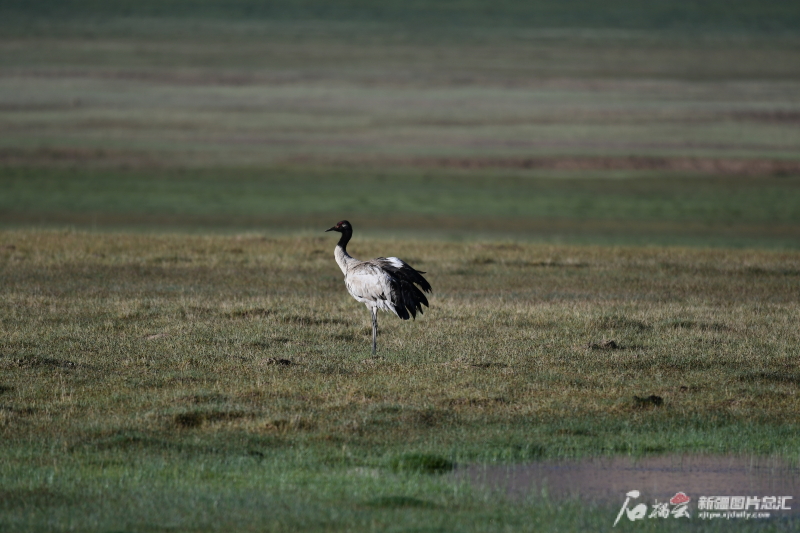Shiliuyun-Xinjiang Daily news (Reporter: Wang Jingjing): When the first rays of the morning sun shone over the bird island in the Yixekpat wetland of the Altun Mountain National Nature Reserve, northwest China’s Xinjiang, Xu Junquan, deputy director of the plateau ecological environment and nature conservation laboratory of the administration of the reserve, was keeping a close watch on a meadow to the south by telescopes in his hands, “The satellite tracker shows that the black-necked crane ‘W00’ has returned, I really want to see this little guy who had its first long distance migration in life again!”

Photo taken on July 1, 2022 shows two black-necked cranes leisurely walk on the bird island in the Yixekpat wetland of the Altun Mountain National Nature Reserve, northwest China’s Xinjiang. (Photo by Shiliuyun-Xinjiang Daily/Jambulat Manarbek)
The black-necked crane ‘WOO’ that Xu wanted to see was born in the reserve in May, 2021, and was fitted with a satellite tracker and a bird band in August. By the analysis of the data collected from ‘WOO’, in July, 2022, researchers found an unusual migration route of black-necked cranes -- a four-day journey of 950 kilometers from their birthplace in the Yixekpat wetland southward to their wintering site in Linzhou County, China’s Tibet Autonomous Region, and then backtracking to their breeding ground after winter. Compared with other six known migration routes of black-necked cranes in China, the distance of this one is medium to long. “But we need more samples to help us to find out the more accurate route,” said Xu.
Black-necked crane is a national first-class protected wildlife, as well as the only crane living and breeding on plateau. Every year from September to October, they fly to the wintering ground with their family and get back to the Altun Mountain National Nature Reserve for laying eggs and breeding their young from April to May next year. The bird island of Yixekpat wetland is one of the breeding grounds of black-necked cranes in China’s northernmost extent, and has 180 to 220 in total that inhabit here in breeding season.

Photo taken on July 1, 2022 shows a black-necked crane walks and forages elegantly on a meadow in the Altun Mountain National Nature Reserve, northwest China’s Xinjiang. (Photo by Shiliuyun-Xinjiang Daily/Jambulat Manarbek)
Since 2021, the reserve and the crane research team of Beijing Forestry University have jointly carried out the satellite tracking and bird banding for black-necked cranes. In addition to this migration route, researchers have also found some immigrating details, “In terms of migration route and time, black-necked cranes in the reserve tend to have a fast migrating pace. During the four-day migration journey, the migration distance can reach 659 kilometers in the first two days, accounting for nearly 70% of the whole journey, without a long stay on the way,” said Xu Junquan.
“Birds are an important part of wetland ecological network and an important indicator of ecosystem health. The attention to birds mirrors people's attention to ecosystem security,” said Chen Jiajia, the person in charge of the Xinjiang project of the crane research team of Beijing Forestry University. “Finding the new migration route means a lot to the multi-area joint protection of and related research works on black-necked cranes. A month later, we will cooperate with the reserve to put satellite trackers and bands for more black-necked cranes, hoping for more data collection that enables deeper research on the migration of black-necked cranes, so as to implement a comprehensive and effective protection.”
(A written permission shall be obtained for reprinting, excerpting, copying and mirroring of the contents published on this website. Unauthorized aforementioned act shall be deemed an infringement, of which the actor shall be held accountable under the law.)









